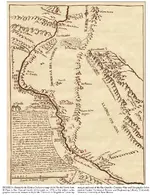whiskeyrat
Hero Member
- Joined
- May 7, 2012
- Messages
- 539
- Reaction score
- 1,248
- Golden Thread
- 0
- Location
- mid Michigan
- Primary Interest:
- Prospecting
Thanks WR.
I definitely do not see the geographic relevancy myself.
The N-S scale on the map is almost spot-on from what I can figure, so those "stumps" would be 1 mile or something from Vic Peak if that's what they are. Why not Bloody Hands petro location just a bit to the north of both Vic and Geronio peaks?
My N-S scaling is based on geographic features in the Caballos, surrounding Hills and the river, and my knowledge of local petroglyph locations and mineral deposits and other features that correspond with a lot of the symbols (again, per my interpretation). I printed the map out on graph paper and tied it to major features, especially the bend at Rincon and the river and the main "breaks" in the Caballos. E-W scale is not as accurate.
Also, BTW, the Caballos ARE on at least one older (pre-anglo) map. 1770 Bernardo Miera y Pacheco. It's a slightly different map than the 1776 or whatever more common one that pops up on the web. I'll dig up a reference and post it in response to SDCFIA's earlier post somewhere which seemed to claim that the name was an anglo invention. The same map has the Point of Rocks labeled as "Perillo" which is very relevant per my research, so it's not a replacement name - lots of things I have discovered vis a vis name drift and precedence are solidified by finding both or all alternate/confused names on a single map. BTW, the Organs are also labeled on this map, and in the correct location.
Anything you can share from your trip to the Organs?
nmth:
when you say the Organs are also shown on this map, which map are you referring to, "willies map" the map with the "stumps" or the Miera y Pacheco map?
I have not made it to the Organs yet. I got involved in some very interesting stuff in the caballos and then had to come back to Michigan to vote for Trump and the firearms whitetail deer season which i am in the midst of now.
Will hopefully head for the organs (I have 3 targets in mind) right after thanksgiving.
You mention local petroglyph locations that match symbols on the "willie" map. I have yet to find petroglyphs in the Caballos. But thats an interesting notion.
I have been trying to match geography but was of the thought that all the symbols, petroglyphs, markers etc in the Caballos had been obliterated.
wr











